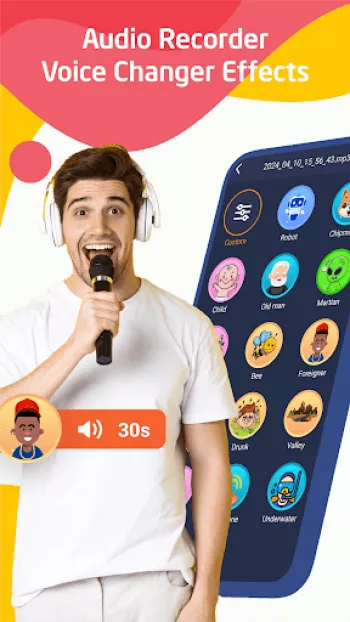Apps Home

Understanding Voice Effects and Their Application
In the realm of audio editing, voice effects play a crucial role in transforming raw vocal tracks into creative and engaging soundscapes. These effects are used to alter the characteristics of the voice, ranging from subtle adjustments to radical transformations. The application of voice effects can serve various purposes such as enhancing the entertainment value, correcting audio imperfections, or creating unique sounds that distinguish a track from others. For instance, a robotic effect can impart a futuristic feel to a vocal, whereas a creepy movie effect might be used to add suspense and tension in horror productions. The array of effects described, such as chipmunk, child, or old man, adds versatility to audio projects, enabling creators to explore auditory dimensions that would have otherwise been impossible with unprocessed sound. Consider the chipmunk effect; it increases the pitch substantially to create a comedic effect reminiscent of the popular cartoon characters. In contrast, the old man effect involves decreasing pitch and adding a touch of raspiness to simulate an aged voice. Understanding how these effects interact with the original audio signal is crucial for sound engineers who seek to maintain intelligibility while introducing creative elements. Effective use of the Martian or alien effects can make dialogues in science fiction media feel authentic and otherworldly. The depth of these effects is particularly enhanced with tools that allow users to apply them not just globally, but selectively within different parts of the audio file, thereby achieving a more nuanced output. Furthermore, as audio content increasingly becomes part of multimedia experiences, these voice effects find extensive use in gaming, virtual reality, and live performances, where they contribute significantly to the immersion and emotional engagement of the audience. Investigating the underlying signal processing techniques, such as pitch shifting, time stretching, and modulation, offers further insights into how these effects are achieved and how they can be refined in the production process.
The Technical Aspects of Audio Editing Software
Audio editing software is the backbone of creating and manipulating voice effects. These programs offer a wide range of functionalities that cater to both novices and professionals in the audio production industry. At the core of these software tools are digital signal processors (DSPs) which can perform complex manipulations on audio signals, such as filtering, equalization, and dynamic range compression. A good voice changer app, for instance, harnesses DSPs to apply effects in real-time, allowing users to hear transformations as they adjust parameters. The user interface of audio editing software often includes features such as waveform visualization, which provides a graphical representation of the audio signal, aiding users in identifying specific areas for editing. A notable aspect of advanced software solutions is their ability to maintain lossless audio quality even after multiple rounds of effect application. Preserving the original sound quality is paramount, especially for professional audio production where clarity and precision are critical. Software ranging from simple apps to comprehensive digital audio workstations (DAWs) also includes functionality to save and export both raw and modified audio in various formats, ensuring compatibility across different platforms. Programs may also offer automation features, enabling users to apply certain effects automatically according to predefined parameters, thus streamlining the editing process significantly. Audio editors often face the technical challenge of latency – the delay between input and output audio – which advanced systems mitigate through sophisticated algorithmic solutions. Furthermore, many modern editors allow users to utilize VST (Virtual Studio Technology) plugins to expand the software's effect library and processing capabilities. This plugin architecture permits integration of third-party effects, thus broadening the creative horizon for sound designers and musicians. As technology advances, AI-driven audio editing is becoming increasingly prevalent, providing intelligent suggestions for effect applications that enhance the workflow efficiency and creative potential of the software.
Practical Applications of Voice Effects in Media
The use of voice effects in media has grown exponentially, parallel to the advancements in audio editing technology. In films, voice effects are indispensable for audio post-production, serving both creative and corrective purposes. They are used to create specific atmospheres and moods, align audio with visual content, and sometimes completely alter an actor's voice to fit a character. For example, the devil and big robot effects are frequently utilized in science fiction and fantasy genres to depict evil or non-human entities, enhancing the thematic elements of the narrative. Meanwhile, in music production, voice effects embolden artistic expression. Auto-tune, chorus, and reverb effects have become staple tools for creating modern vocal tracks, allowing artists to mold their sound to fit various musical styles. Voice effects also play a significant role in podcasts and radio production, where they contribute to storytelling by creating acoustic environments that engage listeners. The practical applications extend to live performances where real-time voice modulation can add a dynamic layer to a performance. In the gaming industry, voice effects are used to immerse players in the game world, assigning distinct sound profiles to different characters and environments. For instance, an underwater effect is perfectly suited for scenes or levels set in aquatic environments, giving players an audibly consistent experience. The ability to record and change voice directly provides flexibility during live recordings or broadcasts, enabling immediate adaptation to changing requirements. Moreover, blending voice effects with ambient sounds and music further enriches the auditory landscape, providing a comprehensive experience that captivates audiences across different media forms. The demand for voice effects in media continues to rise as content creators seek to differentiate their work in a saturated market, often using these effects to add a unique signature to their production.
Innovations and Future Trends in Voice Effects
The field of voice effects and audio editing is continuously evolving, driven by technological advancements that promise to expand creative possibilities. AI and machine learning are at the forefront of this transformation, with new algorithms capable of analyzing and editing audio in ways that mimic human intuition. These technologies are being integrated into audio editing software to facilitate sophisticated effect applications that were previously time-consuming or impossible. Real-time voice transformation has become more feasible with increased processing power and more developed algorithms, allowing performers to alter their voices instantaneously without noticeable delay. Future trends also include the development of personalized effects through voice modeling, where users can train the software to recognize and adapt to their vocal characteristics, leading to more natural and unique transformations. Additionally, spatial audio technology is set to revolutionize how voice effects are applied in virtual and augmented reality environments, providing three-dimensional audio experiences that match visual content more accurately. Enhanced connectivity through cloud-based platforms offers new collaboration opportunities where multiple users can work on a single project from different locations, sharing voice effects and edits seamlessly. These innovations not only enhance creativity but also improve accessibility for users who may not have access to advanced hardware or software, thanks to cloud processing. As consumer demand for customizable audio experiences grows, manufacturers are investing in developing more user-friendly interfaces that simplify the application of complex effects, therefore democratizing audio editing technology. Leveraging blockchain technology to automate licensing and royalty distribution could become standard, ensuring creators are adequately compensated when their unique voice effects are used commercially. As the industry continues to innovate, the intersection of audio editing with other technological fields will likely bring forth yet unimagined opportunities, transforming how we produce and experience audio content.
Choosing the Right Voice Editing Tool
When selecting a voice editing tool, understanding the specific needs of your project is paramount. The marketplace is replete with a myriad of software options, each offering various features and capabilities tailored to different user levels and creative demands. Factors to consider include the complexity of projects, the type of effects required, and whether you need a tool that can operate on multiple platforms. Ease of use is crucial for beginners who might benefit from straightforward interfaces that offer preset effects, such as the normal or chipmunk options, which can be applied with a single click. Advanced users, on the other hand, might seek software that provides a broader array of customizable options, including the ability to tweak parameters for more precise sound manipulation. Cross-platform compatibility can be a deciding factor for those who work in diverse environments. For Android users, the application can be Download for Android, but the absence of dedicated applications for iPhone, Windows, Linux, or Mac necessitates considering software that offers web-based versions. It's essential for teams engaged in collaborative projects to select tools with robust sharing and editing features that can accommodate seamless workflow between different locations and devices. Lossless quality maintenance remains a critical consideration for professional-grade projects where audio fidelity cannot be compromised. Besides, setting audio as the default ringtone is an additional value that some may find appealing for personalizing their auditory environment. Cost considerations, including subscription models versus one-time payments, can influence the choice for professionals mindful of budget constraints while balancing functionality needs. Evaluating the longevity of support and updates is equally important, ensuring that the tool remains functional and relevant as technology evolves. Ultimately, the right voice editing tool not only aligns with current project needs but also scales according to future growth, providing a stable and reliable solution in the ever-expanding field of audio production.
Share Your Opinion
Your Email Will Not Be Published.
All Rights Reserved © Apps Home 2025
















































A Google user
This is an amazing app!! Other voice changer apps, with good quality are darn difficult to find. So far, the voices are more realistic than in othe...
A Google user
I love this app it's really nice! The only part i gave it 4 stars was some voices didnt sound like the real voices. Also I HATE how the bottom ones...
Sweet bean paste
Absolute banger of an app. I like how you can choose to change the pitch of your recording as well. This is my favourite out of all the others I've...
Jocel John Jr. Billones
Wow a perfect voice changer that i downloaded here in play store my voice is definitely look like a girl. But may i suggest that can you add some n...
A Google user
This app is amazing. My little sister is gonna' love it! I enjoy using it and listening to my voice in different sounds(except for the creepy ones)...